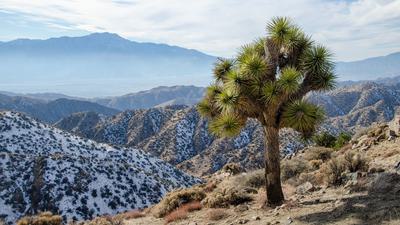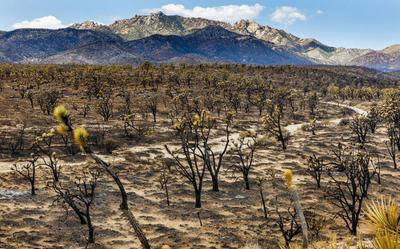In 2020, the Dome Fire swept through Southern California’s Mojave National Preserve, blackening nearly 70 square miles of highly biodiverse desert. The conflagration killed 1.3 million Joshua trees, including most of those on Cima Dome, one of the largest and densest Joshua tree woodlands in the world.
Then in 2023, the York Fire swept through and burned a large section of adjacent Joshua tree forest, killing another million or so trees. The destruction on Cima Dome — which is higher in elevation and cooler than the surrounding desert — came as an especially severe blow to the National Park Service and conservationists who had considered it a stronghold for the eastern Joshua tree and a key to the species’ future.
Experts were planning to make Cima Dome a refuge by clearing out invasive grasses and monitoring the woodland’s health, said Andrew Kaiser, a botanist who worked at the Mojave National Preserve during the fires and now works for the California Department of Fish and Wildlife, developing its Western Joshua Tree Conservation Plan. “The perimeter of the 2020 Dome fire was essentially the exact outline of the model climate refugia. It almost completely overlapped it.”
Studies found that if warming temperatures aren’t mitigated, nearly 100 percent of the trees could be lost in the coming decades.
The number of wildfires that kill and damage Joshua trees has increased sharply in recent years “in significant part due to changes in the desert ecosystem,” said Brendan Cummings, the conservation director of the Center for Biological Diversity, who lives in the town of Joshua Tree and is a leader in the fight to legally protect the trees. “Thirty years ago, a typical fire in a Joshua tree woodland would burn less than an acre. Lightning would hit a tree and it would fall. Rarely would it burn beyond an acre.” Now, he said, larger fires are prevalent.
Such blazes are one of the major threats to Joshua trees: Hotter and drier weather, which kills seedlings and reduces recruitment of new trees, is another important factor. Studies from 2019 and 2011 found that if warming temperatures aren’t mitigated, nearly 100 percent of the trees across their range, which extends across parts of the southwestern United States, could be lost in the coming decades. That’s if development, especially of utility-scale solar farms, doesn’t wipe them out first.
Joshua trees are a species of yucca: With their shaggy bark and their balls of jagged leaves at the ends of crooked branches, they look like something out of a Dr. Seuss book. The Spanish called them izote de desierto, the desert dagger, and the local Cahuilla tribe calls them humwichawa. Mormon settlers are said to have named the tree after the prophet Joshua, who kept his hands raised and spread to guide the Israelites. Mature trees range from 75 years old to more than 300, and seedlings take about 30 years to reach maturity.
The Joshua tree has two distinct subspecies: the western Joshua tree, which occurs mostly in California — including Joshua Tree National Park, a stronghold — and the eastern species, which is found in much of eastern California, southern Nevada, western Arizona, and in a small corner of Utah. Each depends on a single species of moth for pollination — a moth that doesn’t pollinate the other species.
They are also critical to desert biodiversity. “They are keystone species, which means they create more habitat for other species and increase the biodiversity of the overall desert,” said Cameron Barrows, a retired University of California, Riverside, research ecologist who studies Joshua trees. “Everything from red-tailed hawks to great horned owls to Scott’s orioles and cactus wrens — their density and abundance is tied to the availability of nesting sites, and Joshua trees are really the only nesting sites in much of the Mojave Desert.”
The desert night lizard uses its fallen branches for shelter; the threatened desert tortoise consumes Joshua tree flowers; and the blacktail jack rabbit and desert wood rat depend on the water inside their trunk tissues.
Climate change is a major contributor to shifts in the Mojave’s fire regime. The vast increase in acres burned is in part due to hotter temperatures, which increase the growth rate of invasive grasses. The desert’s average temperature has gone up as much as 3.6 degrees Fahrenheit (2 degrees C) in the last hundred years, and rainfall has declined by up to 20 percent in some areas. Precipitation in the Mojave, the most arid place in North America, varies widely but averages 5 inches a year. Joshua trees are highly adapted to the searing heat of the Mojave, flourishing in temperatures of more than 120 degrees F (49 degrees C). But they need moisture, too, and climate change has brought drought.
The York Fire burned roughly a million Joshua trees in Mojave National Preserve in August 2023. L.E. Baskow / Las Vegas Review-Journal / Tribune News Service via Getty Images
Climate change is expected to continue to drive extreme swings in California’s weather in the coming years. And while a couple of recent wet winters have helped new Joshua seedlings to sprout, their survival isn’t assured: Joshua trees need a dependable supply of moisture to make it through their early years.
“The temperature is important, but rainfall is really important,” said Barrows. “If you couple higher temperatures and drier conditions, you are screwed.”
At the same time, wet years also help plant species that threaten the Joshua tree. “Over the last few decades, the invasive grasses originally brought here by cattle ranching and other sources have taken over the Mojave, [changing] the fire regime,” said Cummings. Grasses such as red brome and Mediterranean split grass are highly flammable, and in wet years they grow in profusion and create more intense and far more widespread fires.
There is also concern that the invasion of exotic species, in combination with climate change and the deposition of atmospheric nitrogen — which wafts in from the smoggy Los Angeles basin and stimulates the growth of flammable grasses — will keep the post-fire Joshua woodlands from reestablishing themselves. Instead, those areas could convert to a non-native grassland with low biodiversity.
Ironically, one of the biggest threats to trees are large-scale solar arrays that are being built to help wean California off fossil fuels.
The western Joshua tree has been proposed for threatened status under the California Endangered Species Act and has been regulated, since 2023, by the state’s Western Joshua Tree Conservation Act, which forbids cutting trees from either private or public land without authorization from the state. The federal government, under both the Trump and Biden administrations, rejected federal endangered species protection for both subspecies, most recently in 2023.
One reason for the lack of protection is that there is currently no shortage of Joshua trees — the threat is based on projections of future loss. The population of eastern Joshua trees is estimated to be several million, and the western population contains as many as 10 million trees. Nonetheless, Cummings argues that they are both deserving of protection because the forecasts of the future look bleak. “We know they are on an extinction trajectory, given the threat of climate change,” he said. “If climate change is frozen at current levels, we [still] lose half their range.” Temperatures, of course, are not expected to remain steady.
Another potential threat to the western species is development in the Mojave Desert, where half of the trees occur on private land. (The vast majority of eastern Joshua trees grow on public land.) Ironically, one of the biggest threats to trees are large-scale solar arrays that are being built to help wean the state off fossil fuels. The 530-megawatt Aratina solar-plus-storage project, to be built on private land near Boron, California, would kill nearly 4,000 Joshua trees and reduce habitat for desert tortoises and other species.
The desert tortoise, red-tailed hawk, and black-tailed jackrabbit all depend on Joshua trees. Daniel Elsbrock / NPS; Preston Jordan Jr. / NPS; Brad Sutton / NPS
Solar developers oppose listing the tree as threatened. The California desert, along with the North African desert, has the highest solar radiance in the world, they argue, which makes it prime for generating electricity. “Our grid capacity needs to be expanded by numbers that are almost unimaginable,” Shannon Eddy, executive director of the Large-Scale Solar Association, told Vice News. “We’re just at the very leading edge of figuring this out. So to take huge swaths of the desert and set them off limits to solar development now, before we really know where they need to go, isn’t appropriate.”
The Western Joshua Tree Conservation Act, which grandfathered in some solar projects, came about when the California Department of Fish and Wildlife deadlocked on whether to list the subspecies as threatened. A political compromise, the act passed because it offered more management flexibility than listing the tree.
The act requires the Department of Fish and Wildlife to create — with other governmental agencies, California Native American tribes, and the public — a draft conservation plan for the species by December 31, 2024, and it requires companies to buy permits to cut down or relocate Joshua trees. Fees for permits will be used to create a conservation fund. The plan aims to protect not only the tree, but the larger Mojave Desert ecosystem — including trees, the desert tortoise, burrowing owls, rare plants, yucca moths, and other species — from the crush of development.
“It’s by no means perfect,” said Cummings. “But it will bring things into a rational, orderly, and lawful space. High desert communities have really done a horrendous job of protecting the desert landscape from development.”
Drew Kaiser, a botanist with the National Park Service, inspects invasive red brome grass in Mojave National Preserve. Irfan Khan / Los Angeles Times via Getty Images
One key part of the emerging conservation strategy, which is guided in part by a recent paper published in the journal Biological Conservation, is to protect the trees in refugia, designated areas where the Joshua tree forest is healthy and that might be cooler and less susceptible to drought as temperatures increase. In Joshua Tree National Park, managers are clearing grasses in refugia, for example, to remove fuel and create fire breaks between trees.
Researchers are also mapping the trees’ genomes to predict which populations are most resilient to heat and drought so their preservation can be prioritized or their seeds used for replanting.
Assisted migration — physically moving adult trees to Northern California and Oregon — has been considered. But “you can’t just move the Joshua tree,” Kaiser, from California’s Department of Fish and Wildlife, said. “You’ve got to move the nurse plants [which help seedlings get established]. You’ve got to move the yucca moth pollinator. You’ve got to monitor. All of the research we’ve seen so far suggests it’s not a viable option at this moment in time. But we’re not ruling it out.”
In spite of all these threats, there are glimmers of hope. Increased use of electric vehicles in Southern California, for example, could reduce levels of the atmospheric nitrogen that fuels the growth of flammable grasses.
And there is widespread commitment by concerned partners. “In areas that are well managed, like a national park, I am optimistic,” said Barrows, of UC Riverside. “Interestingly, there are some areas where trees are actually invading up into the pine forest and doing really well because it is higher, cooler, and wetter. So Joshua trees as a species are not going to go extinct, but areas of the Mojave Desert will become more ecologically depauperate if they lose the Joshua tree — unless we can reverse the climate change issue.”







